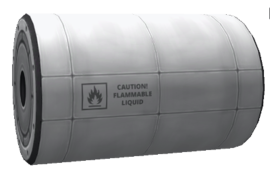Difference between revisions of "Mk1 Liquid Fuel Fuselage"
From Kerbal Space Program Wiki
m (+{{version}} template) |
(Extended comparison) |
||
| Line 9: | Line 9: | ||
== Comparisons == | == Comparisons == | ||
| − | This is the least-efficient by weight of all the fuselages: its mass ratio is only 3.14, with all the others (as of {{version|0.20.2}}) have a ratio of 5. | + | This is the least-efficient by weight of all the fuselages: its mass ratio is only 3.14, with all the others (as of {{version|0.20.2}}) have a ratio of 5. However, its impact tolerance of 20m/s is 3⅓ times greater than the 6m/s typical of rocket and RCS fuel tanks. With the introduction of tweakables, the oxidizer can be removed from rocket fuel tanks giving an even better fuel-to-weight ratio, but landings could subject craft to impact sufficient to break them which the Mk1 fuselage would survive. |
== Changes == | == Changes == | ||
Revision as of 11:13, 9 July 2014
| Mk1 Liquid Fuel Fuselage | ||
| Liquid fuel tank by C7 Aerospace Division | ||
| Radial size | Small, Radial mounted | |
| Cost | (total) | 550.00 |
| (dry) | 230.00 | |
| Mass | (total) | 2.250 t |
| (dry) | 0.250 t | |
| Drag | 0.3-0.2 | |
| Max. Temp. | 2000 K | |
| Impact Tolerance | 10 m/s | |
| Research | | |
| Unlock cost | 2 600 | |
| Since version | 0.15 | |
| Part configuration | mk1Fuselage.cfg | |
| Packed volume | None | |
| Liquid fuel | 400 | |
The Mk1 Fuselage is a round cylindrical fuselage part with a diameter of 1.25 meters. It contains only liquid fuel. It is not to be confused by the Structural Fuselage that cannot store fuel.
Description
| “ | A standard fuselage that carries fuel for spaceplanes. This one is chock-full of jet fuel. Not as resistant as it's counterparts, but jet fuel is more efficient than the other fuels, without mentioning lighter. — C7 Aerospace Division |
” |
Comparisons
This is the least-efficient by weight of all the fuselages: its mass ratio is only 3.14, with all the others (as of version 0.20.2) have a ratio of 5. However, its impact tolerance of 20m/s is 3⅓ times greater than the 6m/s typical of rocket and RCS fuel tanks. With the introduction of tweakables, the oxidizer can be removed from rocket fuel tanks giving an even better fuel-to-weight ratio, but landings could subject craft to impact sufficient to break them which the Mk1 fuselage would survive.
Changes
- Dry mass increased from 0.3 to 0.35, fuel system changes reduced full mass from 1.2 to 1.1.
- Initial release
